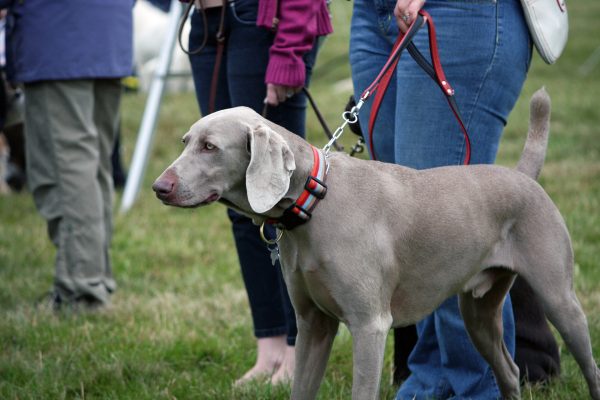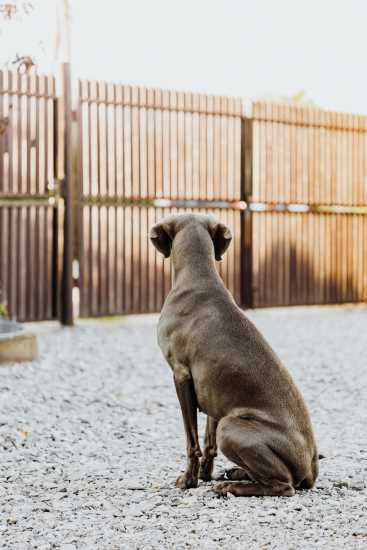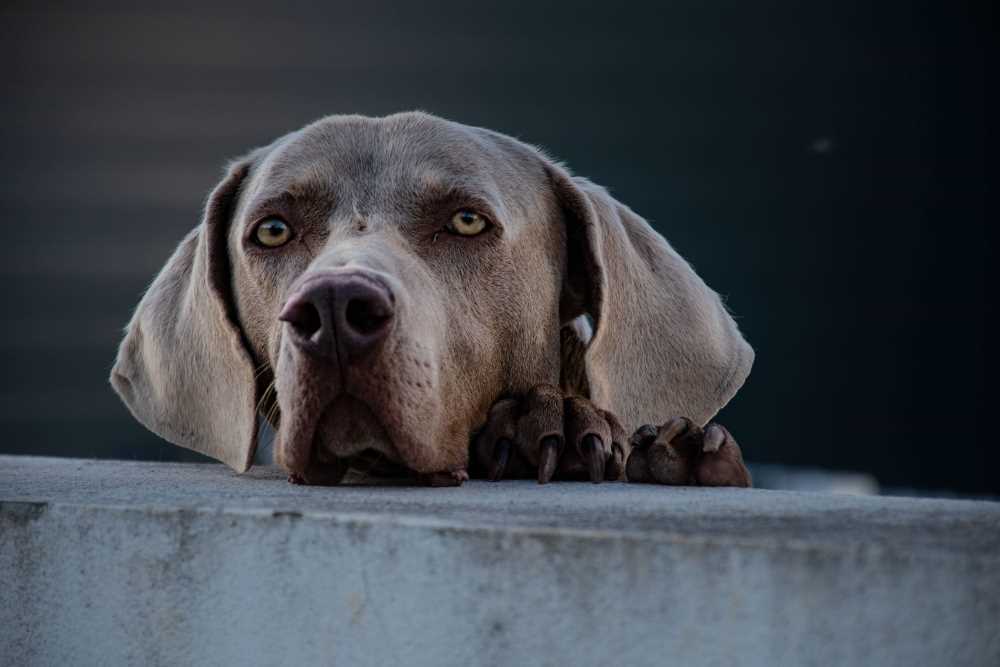Blind dog care is similar to working with a blind person, teaching them to function in their daily activities. You will need to make a few simple changes to your home and teach your dog to move from place to place safely.
As an occupational therapist, I worked with blind people, teaching them how to function without sight. The principles we used are very similar to those used with blind dogs.
In this article we’ll look at:
- Changes to Make in Your Home for Safety
- How to Teach Your Dog to Navigate Safely in Your Home
- Why a Harness and Leash are Important
- Simple Rules to Avoid Confusing Your Dog

Senior dogs frequently do lose some sight, and of course, some become totally blind. When a dog loses his sight, it can happen gradually or quickly, and some blind dogs retain the ability to see light.
For your blind dog’s safety, it is best to keep him on a leash when out and about. Keep in mind that your dog’s blindness is probably much more stressful for you than for your dog. After a short period of adjustment, your dog will be ready to move on.
You need to accept your dog’s blindness too, and it is important that you have an optimistic view and a cheerful attitude.
Dogs feel your moods, and your dog will pick up on your depression or anxiety.
Changes for Your Home
When your dog becomes blind, your once safe home becomes unsafe until your dog adjusts.
Safety is ultra important now, and most changes you need to make are simple and inexpensive.
But keep in mind that you shouldn’t try to do everything below at once. Give your dog a chance to get acclimated to all the changes in his life!
Make your dog’s living space smaller
This can be a temporary situation. Keep your dog confined to a familiar area, a room or two.
Perhaps you could partition off the kitchen and the laundry area with pet gates if they are connected to each other. If you feed your dog in the laundry area, this is perfect. Place a bed or your dog’s crate in her space and let her get used to being in those two rooms.
Gradually, as she becomes familiar with negotiating the layout, you can increase the area she is allowed to roam. As she gets used to each new room, your dog will become able to move from room to room safely.
Stairs
Even if your dog was good at climbing and descending stairs, they are dangerous now. Initially, you would be wise to close off stairways with baby or pet gates.
If you don’t have carpeting on your stairs, consider installing it, as carpet makes it safer for your dog to negotiate. You’ll have to work with your dog, practicing going up and down the stairs together, until he gets the hang of it.
Later, when your dog is moving around well, you can use essential oil scents to tell your dog where the steps start and end. Your dog’s sense of smell is his most developed sense.
Your dog’s crate
If your dog was crate trained, his crate is a safe haven. But, remove the door. Even sighted dogs will occasionally bump into the wire door on their crate.
Keep your dog’s crate in one location. Don’t move it around. Your dog can use his crate as an anchor or a place that he can start from. He needs to know where it is–and it needs to stay there.
Food and water
Just like your dog’s crate, his food and water can serve as a landmark or starting place. Keep them in the same location and don’t move them. They help him know where he is, in relation to other places and things.
In fact, if you use a noisy water fountain for his water dish, your dog can follow the sound to go get a drink. This fountain would make enough noise.
You may even find a dog water fountain with an LED light, so your dog can locate it at night if she still sees some light.
Furniture
Decide on your favorite furniture arrangement and then don’t move your furniture around. Your dog will adjust to the arrangement and will remember where things are.
If your furniture has sharp edges, consider padding the edges with something like foam or bubble wrap. Or simply move that furniture to an area that your dog won’t be using.
Wind chimes
Place wind chimes next to your entrance door where your dog goes outside to do his business. If there is any wind, it will help your dog to orient himself and find the back door entry.
Wooden stairs
These can be slippery, even for people. Purchase some nonskid strips for your stairs to prevent your dog from slipping and falling.
These strips from Amazon are clear, so they won’t make your home ugly. And they were designed for pets, so they won’t irritate your dog’s paws.
In addition, consider using them on outside steps leading into your home, as they can also be used outdoors.
Scatter rugs
If you have scatter rugs in your home, make sure that they have nonskid backing. This will prevent falls for both you and your dog.
Scatter rugs are a common cause of falling for older people, and they can also cause your older Weimaraner, whether blind or not, to fall.
Navigation at Home and Outside
Blind dogs, just like blind people, need help with learning to get around your home and when outdoors. Here are some ways that you can help.
Make a pathway
Use carpet runners to show your dog where it is safe to walk.
Don’t assume she will figure this out on her own, though. Using a short leash, guide her from room to room on the carpet runners to teach her where they are located. After a few runs, she’ll start to get the idea.
Clutter
When your dog had his sight, he was able to navigate around clutter on the floor. That has changed now. He can trip and fall, just like you. And dogs can get hurt.
Make sure your family members all pick up after themselves.
Keep things orderly
Along the same lines, push your chair into the table after meals. Keep things in their place, as your dog can easily bump into something that was somewhere he remembered, but it has moved.
Sounds
If your dog’s hearing is intact, you can also use sounds to help orient her. Play the same radio all day and keep it in the same location. This can help your dog know where he is in relationship to the radio.
To help your dog know where you are, tie a bell to your shoelace or to the bottom of your jeans. Your dog can locate you by following the sound.
Don’t forget to talk to your dog. Tell him what you’re doing, and tell him what you are going to do. Pleasantly talk about things he’s familiar with. Your dog just wants to know that you are there for him.
Outside in your yard
You don’t have to have all the trees removed from your yard. There is a way to let your dog know where they are.
Simply place a circle of wood chips, gravel, mulch or landscape rocks around each tree and bush. Your dog will learn that the change in texture means that a tree or bush is ahead. You can use the same approach about 3 feet from the fence line in your yard.
Don’t plan any new landscape projects, as this will only confuse your dog.
Electric fence
This can help keep your dog from wandering off your property and into the street or from getting lost.
Place mulch or stones where the underground wires are, so you dog knows when she is getting close.
Hot tub or swimming pool
If you have a hot tub at your dog’s level or a swimming pool in your yard, you’ll need to prevent your dog from falling into the water.
When a blind dog falls into water, he will be confused and not understand how to get out of it. He won’t know where the edges of the pool lie.
Sadly, in this case, a dog can drown. Make sure your dog cannot fall into water.
Harness and Leash for Blind Dogs
Even if you have never used a leash for your dog previously, consider using a harness and leash now. The harness gives you more control over your dog’s movement and helps her feel secure and safe.
In addition, a harness is less stressful to your dog’s neck and eyes, especially important if she has glaucoma.
When your dog is first blind, you may need to guide him around the house with a short leash. Use the leash to show him where he can walk safely and where important things like his food, water and bed are located.
Take your dog for walks on his leash. Talk to him and tell him when something or someone is ahead.
So, while you may feel sad to learn that your dog has lost his sight, you can help her adjust to her new circumstances by making some changes to your home and routine. Your dog will adjust more easily than you!






Leave a Reply